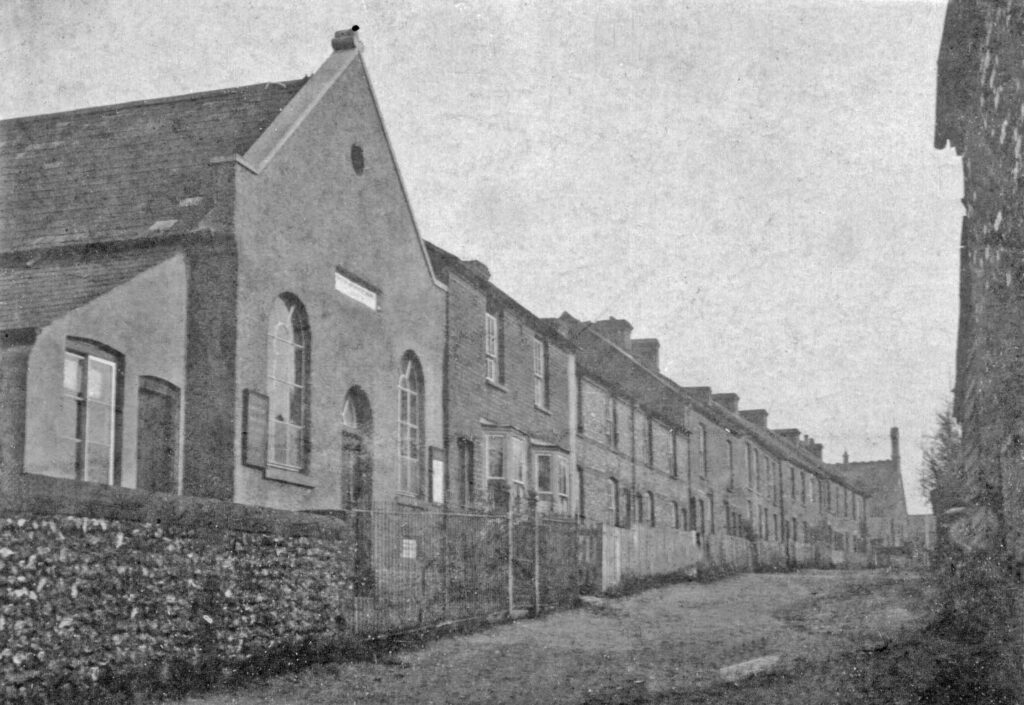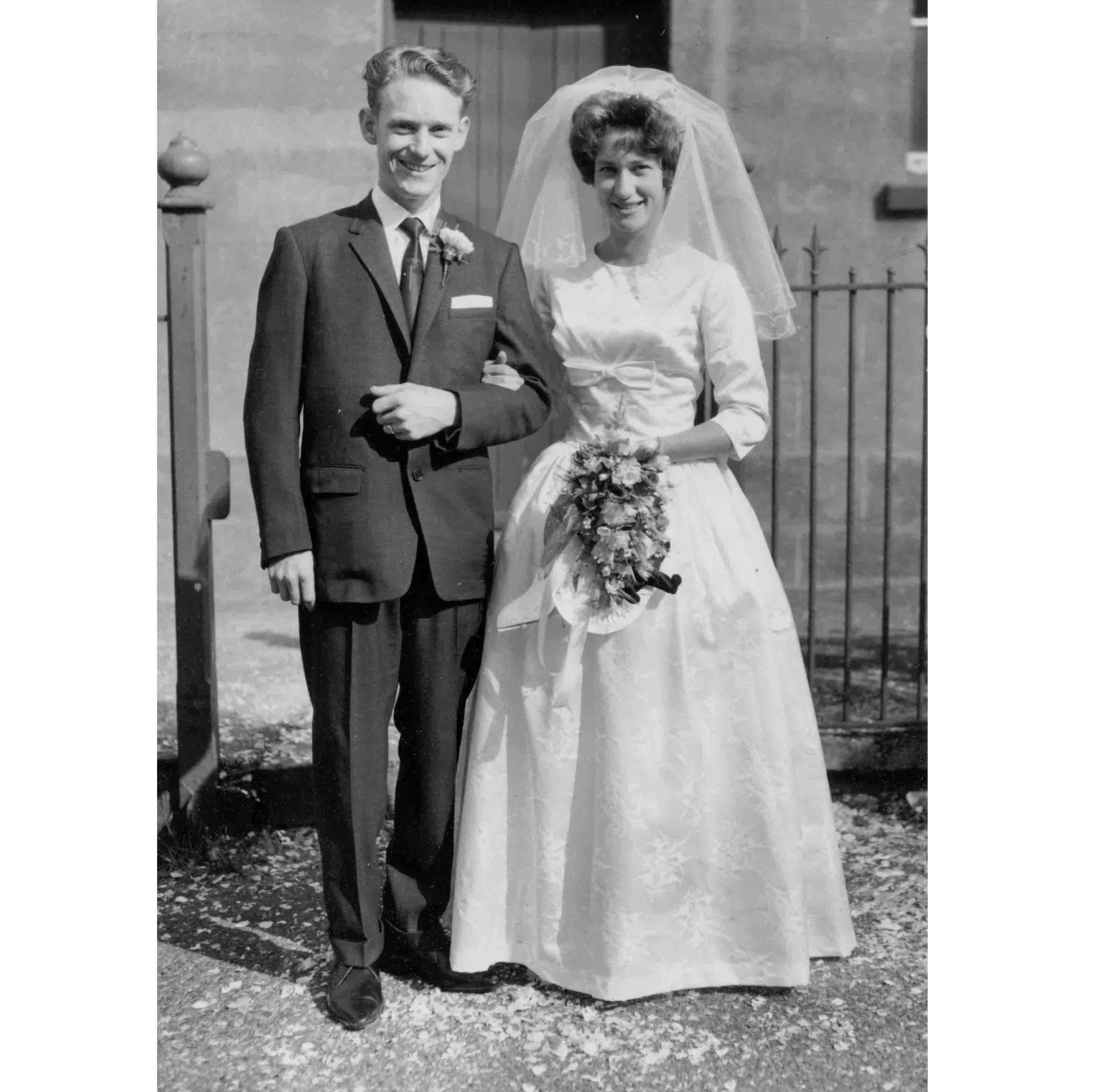How Downley Embraced the Primitive Methodists
There is a curious memorial stone embedded in a wall in The Chapel of Chapel Street, Downley. It’s partly obscured (‘… emorial ston … as laid by …larke Esq.’) and heavily overpainted, but the date is clear: ‘May 31 1887’.
It almost certainly commemorates the 80th anniversary of a very important event in the history of Primitive Methodism: the Mow Cop Camp Meeting of Sunday 31 May 1807, when a ‘great multitude’ gathered on steep hill six miles outside Stoke-on-Trent for a fourteen-hour-long service of prayer and preaching. Hugh Bourne, local wheelwright and the key preacher present, left an account: he wrote of thousands attending, ‘the preachers seemed to be fired with uncommon zeal, … tears were flowing and sinners trembling on every side.’ There was ‘a weighty burning of joy and love’ and many were ‘born again’.
Mainstream Wesleyan Methodists disapproved. Such meetings were ‘highly improper in England and likely to be productive of considerable mischief’; ‘we disclaim all connexion with them’. Disciplined, orderly services were what was needed to keep the authorities happy, not this sort of impromptu open-air preaching and emotional outpouring. (The political context is important here: Britain was at war with revolutionary France and any hint of popular lawlessness was quashed.) Bourne was expelled; three years later, he established the Primitive Methodist Connexion the ‘Prims’.
The Prims made very little impact in Downley at first. Mainstream Wesleyan Methodism took root and the Sunnybank Chapel on Moor Lane opened in 1824. It met a real need. Downley had a fast-growing population what with brick and chair making, but it had no church. The devout had to walk to St Lawrence’s on the hill of West Wycombe for Sunday services and their baptisms, weddings and funerals. It’s a beautiful walk but challenging for the infirm and miserable in poor weather. Walking to Hughenden Church was an alternative, but that was out of parish. Furthermore, both were Anglican churches then considered the ‘Tory Party at Prayer’ – which may not have enthused the local labouring poor.
Small wonder, therefore, that something of a DIY approach to Christianity took hold in Downley. The stirring words of John Wesley, who preached in High Wycombe over forty times between 1739 and 1789, inspired the foundation of the Sunnybank Chapel. Even so, Sunnybank’s services were just too orderly, too establishment, for some.
In 1835, a Primitive Methodist preacher, the Reverend James Pole of Hounslow, arrived in High Wycombe on a six-month mission to heal the area’s ‘shattered bulwarks of Zion’ and end its reputation for drunken depravity (which had been much in evidence during the Paper Riots of 1831). Someone – possibly William Tomkins the Younger, a wheelwright – invited him to preach up in Downley. According to Rev Pole’s journal, his messages of repentance and salvation were warmly received:
Friday 10 April I preached at Dounly [Downley], a new place. A friend who had heard of my coming, had prepared a wheelwright’s shop and it was crowded with people of all classes. Here seemed a good opening.
Saturday 11 April Visiting and praying with the people. Dounly is an obscure village; but it has a chair manufactory, which employs near forty hands.
Tuesday 14 April At Dounly; visited several families. At dinner time held a prayer meeting in the open air: there were more than a hundred people, and God was working. At night the wheelwright’s shop was crammed, and many could not get in. Several wept, and some found peace with God.
Wednesday 15 April Visited at Dounly, and at noon held an open-air prayer meeting; and much interest was excited.
Sunday 19 April P. Meeting at Dounly, and then class, the first ever held by the P. Methodists in this county. Eight joined and may be said to be a foundation stone of P. Methodism in this vicinity. I pray God it may rise to a glorious structure.
Monday 20 April It being Easter Monday we held a meeting on Dounly Common. Several lately converted engaged in prayer; this made a move, and stimulated others to prayer. The scene was both delightful and affecting: some praising God for deliverance and praying him to keep them in future – others crying for mercy.
Tuesday 28 April At Dounly in the open-air. A large Congregation, a mighty influence prevailed and a powerful conversion took place.
Monday 4 May At night preached at Dounly. In the P. meeting after, several were crying for mercy, and some were brought into liberty.
The ‘considerable mischief’ anticipated by the Wesleyans did not materialise. On the contrary, the local constable was much impressed. He dined with Rev Pole on Tuesday 21 April and observed that, ‘He had not before witnessed such an Easter, for every Easter since he had been constable, he had been called out to keep the peace, but this time there was no need of it, for most of the people were praying and at worship on the Common.’
However, Downley’s enthusiasm for Pole’s evangelical Primitive Methodist approach was far from steadfast. William Tomkins the Younger took out a license to use his house as a meeting place on 4 November 1835, but he must have moved elsewhere since he is not in the 1841 census. In late September 1840, Rev John Guy from the Reading Primitive Methodist circuit reported that, ‘A Camp meeting being held at Downley, the preachers and members rose into mighty faith and looked for better days. Persecution soon rose and through this we were at a loss for a place for evening services.’ Another preacher, Brother Joseph Ives, wrote that his ‘soul was much oppressed on account of the low state of religion in this neighbourhood.’ (Naphill was included in that comment.)
In 1841 the fortunes of the Downley Primitive Methodists were revitalised by Brother S. Folly who ‘stirred (Downley) up to diligence’: ‘each member began to pray and believe for a revival’. He organised joint Naphill-Downley Easter week meetings that year which were clearly a success. ‘On Easter Sunday the services were well attended; believers were strengthened, and sinners appeared to be greatly concerned.’ On Easter Monday he organised, ‘A little Camp meeting. Brothers Roberts and Watson, and Sister Gray spoke with power; and there was great power in prayer. Several were in tears during the afternoon. In the evening we had a band or fellowship meeting and one soul found the Lord.’
Unfortunately, there is then a twenty-three-year gap – a vacuum in the records – between those early Downley Prim meetings, and the building of The Chapel on Chapel Street in 1864. It is possible that meetings were held in a private house during that time, or that open air camp meetings continued, or that folks walked to High Wycombe’s two Primitive Methodist Chapels, which opened in 1843 and 1848, or (more likely) to Naphill’s Chapel which opened in 1851, and which had over 200 attendees by 1854.
In the 1851 religious census, eleven percent of High Wycombe were Primitive Methodists. If that proportion was reflected in Downley, then about fifty Downley folk may embraced the Prims by the 1860s which, as it happens, was exactly the capacity of The Chapel on Chapel Street.
By 1864 the Primitive Methodists had finally raised enough money to build themselves a place of worship, albeit a small one, and applied to Lady Dashwood for some land, which was gifted, sans the mineral rights. The Chapel of Chapel Street had a platform, a pulpit, a table, chairs, and an organ, which had to be pumped by a volunteer. On the side, there was a small room (now demolished) that was used for a Sunday School.

Downley now had two chapels, and there seems to have been an intense rivalry between the two. They each attracted a different sort of person, perhaps, with the Chapel Street worshippers probably coming from the poorer houses. Even when the two branches of Methodism – the Wesleyan and the Primitives – formally united in 1932 on a national scale, there was little co-operation in Downley. Ignoring the new ‘union’ with the Sunnybank Methodists, The Chapel held its own services, at 6 or 6.30 pm every Sunday for a further thirty years.

Norman Brown remembers these early evening services well: he was the only child present, since he came to help his blind father, Leslie, the village shop keeper. The Chapel’s square interior was plain and spotlessly clean. In the 1940s, about thirty people attended, with enthusiastic singing accompanied by Mrs Hatton of Commonside on the organ, and stirring sermons provided by a guest (Lay) Local Preacher from within the High Wycombe Circuit. Reg Langley recalled one sermon that made sparks fly: ‘Arthur Hawkins [the Steward] became so angry with the preacher for talking politics that he jumped up and told him to be quiet!’
Four times a year, Communion was held, in a more informal way than in an Anglican church, but still requiring an ordained Minister, who was usually the Circuit Superintendent Minister based at Wesley Chapel in Priory Road, High Wycombe. The table was covered with a linen cloth and then, for reasons he never fathomed, Norman was always asked to withdraw.
In addition to services, a successful Sunday School met in The Chapel at 2:30 pm (so timed because the bus service only started after lunch on a Sunday). It drew a wider crowd ‘from more distant parts of the village like Littleworth Road’, remembers Norman, and was run by Arthur Hawkins, or his father, Leslie. Singing at Sunday School was unaccompanied; occasionally there was a guest speaker. There is a wonderful photo of a Chapel Sunday School meeting, taken at the end of the Second World War or shortly thereafter, when film became available once again. Norman recalls that someone in the village with a Kodak Brownie box camera had offered to take a photo, which explains the larger-than-usual turn out, smart coats, and ribbons in hair.

From left to right, the back row were: Peggy Mines; David Hawkins (the son of Arthur, and soon to be a Sixth Form prefect at RGS); an unknown young lady; Arthur Hawkins (The Chapel’s Steward, not ordained, who died in 1962); Ethel Hawkins, his wife (‘a lovely soul, very caring’); Leslie Brown (who was blind, and ran the village shop); and his son Norman Brown, aged 10 or 11, in Cub Scout uniform. Norman went on to become an Anglican priest: now retired and in his 80s, he ‘realises how much [he] was influenced (for good) at The Chapel’.
In this fashion, with its Sunday Schools and evening services, baptisms and weddings (after it was licensed for weddings in 1943), social evenings, a youth club, harvest auctions, and events for the Sick Fund, The Chapel stayed in use until 1964. By that time numbers had so declined that the decision was taken to end 100 years of Primitive Methodism in Downley.

For a while, the building was used for storage, then in 1985 it was sold and converted into private dwellings. The conversion sadly covered up most of the evidence of the building’s past, other than the internal 1887 memorial plaque, and a round window high up at the back. The Prims had the final word, though: by its deeds, no inhabitant of The Chapel can host a wrestling match, sell alcohol, gamble, or operate machinery, within.
There is two pleasing incidental postscripts to this history: The Chapel’s Bibles were given to Sunnybank; and The Chapel’s original windows and railings ended up in Blacksmiths Cottages, where the windows are now part of the conservatory, and the railings hold up the compost heap. It seems appropriate: it was the wheelwright of Downley who welcomed in Reverend James Pole, 150 years earlier.
